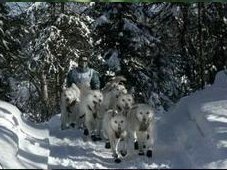Research Suggests Sled Dogs Are Physically Superior
Normally each team will race for around six hours and then rest for the same time, but some teams will race more slowly for eight hours and then rest for six. Each team can consist of a maximum of 16 dogs. It is unclear how they can keep running, despite heavy blizzards, temperatures as low as -40?F, and winds up to 60 mph. No other animal has been found to come close to the physiological attributes these dogs display.
"These are one-of-a-kind athletes," says Davis. "What we learn from them will undoubtedly tell us a lot about human performance as well."
Davis and his colleagues have uncovered three key elements of the sled dogs’ abilities: A rapid adaptation to exercise and endurance; an enormous aerobic capacity; and the use of a high-fat diet. The most striking feature of these canines is their ability to rapidly adapt to sustained strenuous exercise in 24-48 hours. Conditioned dogs display most of the metabolic changes that are found in human endurance athletes during their first day of exercise, including depletion of muscle energy reserves, increases in stress hormones., evidence of cellular injury (such as to proteins, lipids and DNA), and oxidative stress. However, with subsequent consecutive days of exercise at the same intensity, these changes are reversed within 4 days after the exercise begins, where as in humans it may take a full day of rest to return to normal.
Racing sled dogs have enormous aerobic capacity. While the untrained sled dogs have an average aerobic capacity of 175 ml/kg/min VO2 max (ratio of volume of oxygen to body weight per minute), the aerobic capacity of the fully conditioned sled dogs is estimated to be about twice that (300 ml/kg/min). During a typical day’s racing, a sled dog will consume the equivalent of 24 McDonald’s Big Macs, where as a human would require 72 – indicating that the dogs metabolism is finely tuned to supporting exercise through diet.














